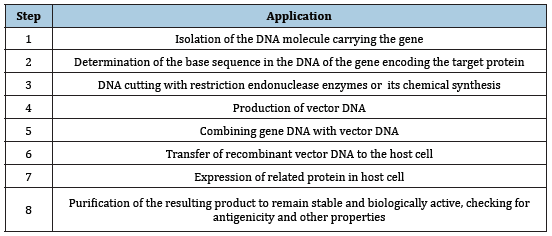General
Overview of Recombinant DNA Technology Applications and Usage Areas in Clinical
Microbiology by Gülnur Tarhan* in Cohesive Journal of Microbiology &
Infectious Disease_ Journal of Microbiology

Abstract
Recombinant DNA technology
is the desired modification of genetic material in-vivo. This technology
involves inserting DNA fragments from various sources and transferring the
desired DNA sequence with a vector. Manipulation in the genome of the organism
can be accomplished by adding new genes or by limiting the activity of existing
genes. Enzymatic digestion is used to obtain different DNA fragments. The DNA ligase enzyme is also used to insert DNA fragments into the
vector. The vector is then transferred to the host cell. As the host cells
proliferate, multiple copies of the vector and DNA fragment occur. In the last
step, the cells carrying the transferred DNA sequence are selected and
amplified. Today, most of the products used in the field of medicine, food,
chemistry, biology and
agriculture are produced with recombinant DNA technology. This technology has
become the basis for more advanced methods that are in use today
Recombinant DNA, which means
combining two different DNA molecules, is a name given to molecular biology
techniques commonly used for years [1]. Recombinant DNA technology and genetic
engineering methods and concepts have been developed as a result of long
studies on the basic structure of DNA molecule
Please click on the link: https://crimsonpublishers.com/
For more articles in Journal of Microbiology,
Please click on below link: https://crimsonpublishers.com/cjmi/
Follow On Publons:
https://publons.com/publisher/6342/crimson-publishers/
Follow On Linkedin:
https://www.linkedin.com/company/crimsonpublishers/
High impact journals in Crimson Publishers?
https://www.quora.com/What-are-the-high-impact-journals-in-Crimson-Publishers


No comments:
Post a Comment